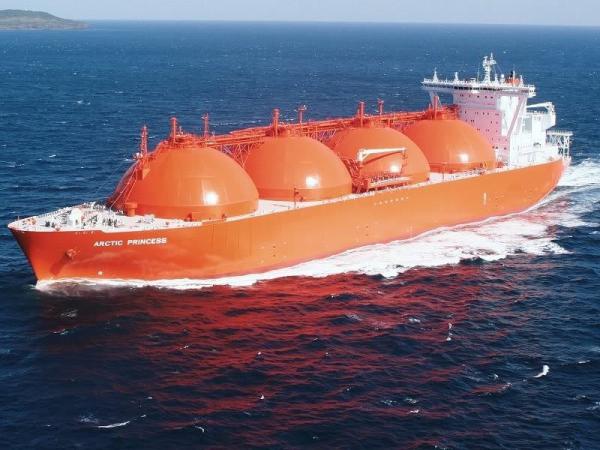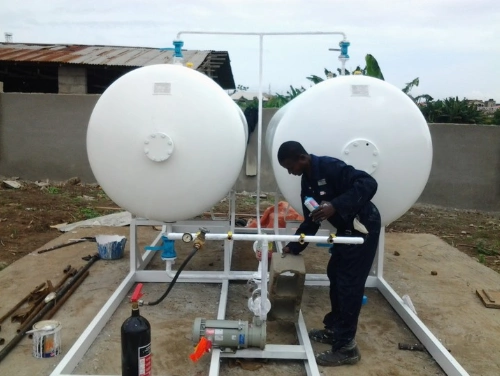
Tragic events always leave us with unanswered questions, and the explosions at multiple Nigerian gas plants involving a suspected gas leak are no exception. The most obvious of these inquiries is how and why it occurred, but one of the most pressing questions we can ask right
now is, "How can we prevent this from occurring again?" An explosion at liquefied petroleum gas (LPG) plant occurs when a gas leak is occurs around an igniting source. (LPG) commonly known as cooking gas is a flammable mixture of hydrocarbon gases used as fuel in heating appliances, cooking equipment, and vehicles. The role of LPG has been largely positive over the last two decades. LPG has contributed to reduce carbon emissions and provided reliable support and back-up for renewable energy. Two of the biggest de-carbonizes on an absolute and relative basis are the United States and the United Kingdom. They have dramatically reduced their coal burn in the power generation sector while greatly increasing the penetration of natural gas. In the United Kingdom, a modest carbon tax has been adopted to essentially eliminate coal from the country’s power generation mix. The United States has no carbon tax, but the shale gas revolution has lowered the cost of natural gas to a level that leaves many coal-fired power plants unable to compete. In Europe and Korea, despite the occasional policy inconsistency, trends are in a similar direction, the combination of renewables and cooking gas is pushing coal out of the mix. Starting a LPG plant in Africa requires the involvement of the government agency to seek approval. In the case of Nigeria, Department of Petroleum Resources (DPR) is in charge.
LPG may leak as a gas or a liquid. If the liquid leaks it will quickly evaporate and form a relatively large cloud of gas which will drop to the ground, as it is heavier than air. LPG vapours can run for long distances along the ground and can collect in drains or basements. When the gas meets a source of ignition it can burn or explode. However, the Department for Petroleum Resource (DPR) requires a number of requirements to help prevent fire or similar accidents in a gas plant. These requirements are contained in the DPR Guidelines for LPG plant published in 2010, and based on the PETROLEUM REGULATION 1967. Determining how and where to set up a cooking gas plant entails involving the DPR as regulatory body that represents the federal government and consulting an expert in the field. The Kiakiagas Nigeria limited with a reputable recommendation in setting up gas plants not only in LPG but also CNG/LNG, autogas, oxygen plants and shipping is the right and best to think of. Our team is up to task and we make use of imported materials as directed by the DPR. Our team has been trained to ensure that installations are made with the most up-to-date technologies. We can also help you obtain the necessary permits and ensure that all gas pumps and dispense systems are thoroughly certified and tested. Kiakiagas is a one-stop-shop for all things gas, from pipeline to pump. As an added bonus for convenience stores, Kiakiagas carries leading gas pump and dispense equipment manufacturers such as Casper.
We present these excerpts from the requirements according the various procedures.
Application Procedure According to the DPR
· Statutory Documents and Design Diagrams
· A copy of Safety, Health and Environment (SHE) proposal for the proposed plant and Environmental Impact Assessment report of the site
Construction Procedure
Liquefied Petroleum Gas must be stored under pressure in vessels designed to withstand safely the vapor pressure at the maximum temperature. Construction of such vessels must be to an acceptable design code.
· The Nigerian Standards Organization approved standard on pressure Vessels and Liquefied Petroleum Gas containers N1 S220/85
· The American Petroleum Institute standard 2510(2)
· The British Standards (BS) 1500 PART 1, fusion welded pressure vessels for use in the chemical, petroleum and allied Industries pr BS15500 for new vessels design, construction, test and certification.
· The installation/construction of piping, instruments and the plant must be carried out by an accredited DPR Company
· The American Society of Mechanical Engineers (ASME) boiler and pressure for use in the chemical, petroleum and allied construction, test and certification.
· The materials used for the construction of the filling shed must be noninflammable material.
· The filling shed must be open-sided for good ventilation

This process might look complicated, however, with our knowledge, experience and cordial relationship with the DPR officials, Kiakiagas will easily get all the required papers for you while saving your resources and without you going through the stress. Kiakiagas possess LPG implementation skills with which you can have your papers and other necessary document that back up your propose LPG plant from not only the DPR but also other LPG regulating government agencies. Kiakiagas will guide and direct you to the next point of action after acquiring the necessary papers. We are good at what we do and we do not abandon our clients or upcoming entrepreneur in the field of LPG. Our reputation speaks for us in the gas industry. Now let us move on to causes of gas explosion
Causes of gas explosion
Natural gas does not have an odor by itself, which is why gas providers normally add an odorant to it. When you add the smell, you'll be able to tell if there's a gas leak in your home or company. Causes of gas leakage include:
· Violations of Safe Code: Violations of codes and standards governing the safe handling of gas or propane;
· Faulty Procedure in Building: Faulty manufacturing procedures used in building gas tanks for automobiles;
· Rust Pipeline: Old worn-out, rusty gas lines causes leaking due to gas lines being hooked up incorrectly;
· Defective Equipment: Defective equipment, including gas grills, acetylene torches, and other equipment that uses gas as a power or fuel source;
· Location gas plants near Illegal structures: This can also be responsible for gas plant explosion. In one of our surveys in some parts of the country, we encountered some illegal structures which can quickly ignite gas plant explosion. In these two scenarios, a gas plant built very close to residential house and another gas plant built near mechanic site can easily ignite gas plant explosion
Useful Tips for Preventing the Gas Plant Explosion
Hazardous substance or not, the gas plant explosion incident in Nigeria clearly demonstrates the importance of taking every imaginable precaution both before and at the first sign of a potential gas leak.
v Install gas detectors wherever there is a risk of gas accumulating, as well as where people will be able to hear the gas detector sound. Heat rise or flame-sourced radiation in the UV, visible, and infrared spectrum can be used to detect fire, guaranteeing that all sorts of fires are identified.
v Regularly maintain and monitor gas detection equipment. Check to see if the batteries are in good operating order. It is also a good idea to have your gas detectors tested by professionals on a regular basis
v Keep all combustible materials away from water heaters, furnaces, and other gas appliances to lessen the risk of a fire.
v At least two dry powder extinguishers less than 9kg each and suitable for LPG fires with a test fire rating of at least 21A and 183B as defined in MSA EN 3-7:2004 should be readily available at strategic locations to deal with fires adjacent to the meter/vehicle being filled.
v Stations storing LPG for Autogas should have a clean water reservoir of minimum size 108 m3.
v Adequate steps should be taken to prevent the unauthorised interference
with vessels and ancillary equipment such as lockable covers. When the site is closed the equipment should be protected from unauthorised interference or operation by isolation of electrical supplies, locking nozzles and locking of cabinet doors of ancillary equipment.
v All notices shall be conspicuous and easily understood by those to whom
they are directed. Where possible they should conform to EN 92/58 – Safety Signs and Colours, or equivalent, and where relevant, to the Work Place (Provisions of MOSR, 1997).
v An emergency telephone number for summary assistance should be displayed at sites accessible to the public in a position where it can be seen even if the site is closed.
What to do in event of a LPG detection
Many individuals/gas plant managers are still unclear on what to do if they discover a gas leak on their property, despite the fact that this precaution has saved thousands of lives over the years. This is what to do in the event of a leakage:
· You need to leave the premises/building immediately. Do not waste time gathering your things
· If applicable, extinguish any open flames on your way out
· Do not turn lights off or on, use a phone to call emergency centers, plug in or unplug any electrical appliances, or anything else that might causea spark
· Do not re-enter the premises until a gas company has inspected the premises and deemed it safe
Training is vital both to help prevent incidents and to minimize the consequences should an incident occur. Employees who may be called upon to use the filling equipment must have adequate training in its proper use, and the action required in the event of mal-function or to deal with an emergency. The training may take many forms, including the giving of instructions (verbal or written) and formal training courses. We just give you another reason to invite our team of experts at Kiakiagas to guide and put you through on how to prevent dangers associated with gas leakages in details. We embark on the use of our vast experience in training your personnel to meet the DPR safety requirements. Our team of researchers will mediate between you and DPR to get you and your personnel a detailed training to help prevent gas hazards in your company so as to be free from the DPR sanction.
In the case of a substantial spillage or a leak of LPG, isolate the electric supply to all fuel dispensers, stop the flow of LPG if possible, call the nearest Fire Department, keep personnel and members of the public away from the area in which the vapour is spreading, alert neighbours to the danger, especially if there are nearby cellars or basements in which vapour could collect, if necessary call the police so that they may re-route traffic and advise the Department and other appropriate authorities of the incident. The installation shall have to conform to any legal inspection and maintenance regulations pertaining to the conditions of its license. It is required of the user to ensure that a Written Scheme of Periodic Examination is drawn up by a competent person. The user shall ensure that the system is properly maintained so as to prevent danger. When used at point of sale, meters need to be maintained to ensure dispensing liquid LPG within the tolerances specified in DPR guidelines. Surveys and maintenance should be carried out in accordance with a documented programme to the suppliers' recommendations and/or based on the Mineral Oils (Safety) Regulations 1997.
KiakiaGas Limited is a leading Gas business in Lagos, Nigeria with expertise in commercial gas pump and dispenses equipment, LPG retailing, New Gas Market development, Building of Gas Plants and Gas strategy advisory. Supply by KiakiaGas provides LPG products and equipment for corporate and institutional clients for the project and operational needs. If you need a partner with hands-on local expertise in the Nigerian Gas space or any of our bespoke solutions/services, kindly Mail hello@kiakiagas.com to learn more.to learn more.
Facebook: Kiakiagas.com
Instagram: @kiakiagas
Twitter: @kiakiagas





